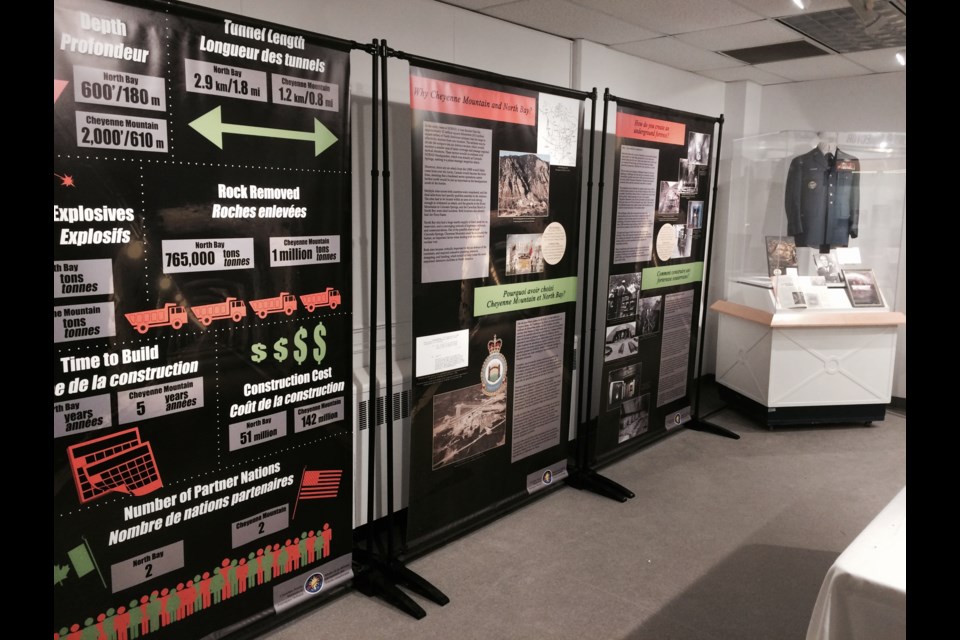In recognition of NORAD’s 60th anniversary, the Canadian Forces Museum of Aerospace Defence at 22 Wing North Bay has launched a new exhibit ‘Below! NORAD’s Underground Fortresses.’
It is a comparative exhibit connecting North Bay’s Underground Complex with the Cheyenne Mountain facility in Colorado.
“We decided to do this in earnest because this year is NORAD’s 60th anniversary. So this ties in really well to showcase the Canadian and American relationship, and also North Bay’s contributions,” explained museum curator Bethany Aitchison.
“North Bay was the Canadian Air Defence Sector, which is what we call ourselves now. What that means is that all of the air defence was controlled out of here in North Bay. The Cheyenne Mountain facility was the headquarters. So everything from all of the sectors was going to Cheyenne Mountain. We were the only region that was underground. All of the American ones were surface facilities and everything was forwarded to their headquarters,” explained Aitchison.
Canada only had one regional control center and it is located in North Bay.
“Mind you, especially in the earlier days of NORAD, not all of Canada was being monitored from Canada. Some of the airspace was being monitored from American stations, but because of NORAD and the relationship between us and the United States, everything is a true partnership it didn’t really matter that that border wasn’t really there.”
As Aitchison explains, the underground complex was designed to withstand an attack, and still be able to watch for future attacks.
“If NORAD’s whole point is to have the eyes in the sky, to be able to watch for incoming threats to North America, in theory, all you’d have to do is wipe out one of those sectors and suddenly you’ve lost your eyes in that part of the sky. Because Canada is the further north, between us and the United States, we were going to be that frontline if anything was coming in from the Soviet Union. If something were to happen, they could close up and continue watching for those further attacks coming into North America.”
In the event of an attack, the doors would be closed with everyone locked inside.
“The people down there could survive for up to about 30 days. They had the freshwater reservoirs, they had food, medical facilities, they had a gym, there was a barber down there, there was a small chapel. So in theory, they could survive for up to a month, but it was never designed as a mass bunker.”
The hole as it is also known officially closed in 2006. It was replaced by an above-ground facility.
Wing Public Affairs Officer, Captain Dawn O’Connor describes what the hole looks like today.
“The Underground is just basically being kept at par. Anything that’s combustible has been removed, so it’s very safe down there. However, we don’t offer tours, there’s nothing that goes down there, except people doing repairs like removing loose rock and emergency crews for them if needed,” said O’Connor.
“There’s nothing in there right now. Even if you went into the old operating rooms, you have to really use your imagination to picture anything that was there.”
NORAD’s mission is the same today, as it was 60 years ago.
“Its mission is the defence of the North American continent. They way it does it, has changed dramatically with technology. Of course, we’ve gone from using enormous computers and living in these underground spaces to do all this, and now we’re in these very modern facilities with modern technology, modern tactics. So what they’re doing is really quite the same. How it’s being done has changed quite a bit," explained Aitchison.
The new exhibit explains the relationship between Canada and the United States, in terms of air defence.
“There are artifacts from our own collection here. We do have a pretty big collection of artifacts from the underground. And we do have a permanent exhibit on the Underground anyway, so this is going to be new stuff that we don’t normally have on display. We also artifacts on the way from the Peterson Air and Space Museum at Peterson Air Force Base in Colorado. “
The exhibit will be up until the end of the year.



